UPDATED ANSWER BELOW
The BGP packet shown in Wireshark has marker field (16 x ff) followed by length 16 (00 10).
Thus, this is indeed the scenario that you wanted to test: your tester BGP speaker sent a BGP packet with an incorrect length, and the remote BGP speaker under test should respond by sending back a NOTIFICATION packet with error code "Message Header Error" and error sub-code "Bad Message Length".
Wireshark is showing the malformed BGP packet that was sent from the tester BGP speaker to the BGP speaker under test. Wireshark is correct to complain that it is a malformed BGP packet: it is malformed because the length is invalid. Evidently, Wireshark is not very specific about what it doesn't like about the packet.
You should look in the TCP stream in the reverse direction (source 10.0.0.2 destination 10.0.0.1) and look for the BGP NOTIFICATION packet that the BGP speaker under test sent back.
UPDATED ANSWER STARTS HERE
Based on the error message ([Error] bgp_read_packet error: Connection reset), it looks like you are testing Free Range Routing, or one of its predecessors Quagga or Zebra.
I reproduced the scenario you are testing.
I am running a Free Range Routing (FRR) BGP speaker with the following configuration:
Current configuration:
!
frr version 7.1-dev-MyOwnFRRVersion
frr defaults traditional
hostname ip-172-31-31-121
log file /var/log/frr/debug.log
log syslog
service integrated-vtysh-config
!
debug bgp neighbor-events
!
router bgp 100
neighbor X.X.X.X remote-as 200
!
line vty
!
end
I use the following Python test program to send a message with a "too short" header:
#!/usr/bin/env python3
import socket
BGP_IP = 'Y.Y.Y.Y'
SHORT_MSG = (b'\xff\xff\xff\xff\xff\xff\xff\xff' # First 8 bytes of marker
b'\xff\xff\xff\xff\xff\xff\xff\xff' # Last 8 bytes of marker
b'\x00\x10' # Length 16
b'\x01') # Open
def main():
sock = socket.socket(socket.AF_INET, socket.SOCK_STREAM)
print("Socket created")
sock.connect((BGP_IP, 179))
print("Socket connected")
sock.send(SHORT_MSG)
print("Short message sent")
while True:
data = sock.recv(1)
if data == b'':
print("Connection closed or reset")
break
print("Received:", data)
if __name__ == "__main__":
main()
Replace X.X.X.X with the IP address of the tester, and replace Y.Y.Y.Y with the IP address of the BGP speaker under test.
In this scenario, the BGP speaker under test does indeed send the correct NOTIFICATION message.
Here is what the FRR log reports:
2019/02/09 21:49:05 BGP: 172.31.17.121 [FSM] Timer (connect timer expire)
2019/02/09 21:49:05 BGP: 172.31.17.121 [FSM] ConnectRetry_timer_expired (Active->Connect), fd -1
2019/02/09 21:49:05 BGP: 172.31.17.121 [Event] Connect start to 172.31.17.121 fd 26
2019/02/09 21:49:05 BGP: 172.31.17.121 [FSM] Non blocking connect waiting result, fd 26
2019/02/09 21:49:05 BGP: bgp_fsm_change_status : vrf 0, established_peers 0
2019/02/09 21:49:05 BGP: 172.31.17.121 went from Active to Connect
2019/02/09 21:49:05 BGP: 172.31.17.121 [Event] Connect failed 111(Connection refused)
2019/02/09 21:49:05 BGP: 172.31.17.121 [FSM] TCP_connection_open_failed (Connect->Active), fd 26
2019/02/09 21:49:05 BGP: bgp_fsm_change_status : vrf 0, established_peers 0
2019/02/09 21:49:05 BGP: 172.31.17.121 went from Connect to Active
2019/02/09 21:49:08 BGP: [Event] BGP connection from host 172.31.17.121 fd 26
2019/02/09 21:49:08 BGP: bgp_fsm_change_status : vrf 0, established_peers 0
2019/02/09 21:49:08 BGP: 172.31.17.121 went from Idle to Active
2019/02/09 21:49:08 BGP: 172.31.17.121 [FSM] TCP_connection_open (Active->OpenSent), fd 26
2019/02/09 21:49:08 BGP: 172.31.17.121 passive open
2019/02/09 21:49:08 BGP: 172.31.17.121 Sending hostname cap with hn = ip-172-31-31-121, dn = (null)
2019/02/09 21:49:08 BGP: 172.31.17.121 sending OPEN, version 4, my as 100, holdtime 180, id 172.31.31.121
2019/02/09 21:49:08 BGP: bgp_fsm_change_status : vrf 0, established_peers 0
2019/02/09 21:49:08 BGP: 172.31.17.121 went from Active to OpenSent
2019/02/09 21:49:08 BGP: 172.31.17.121 bad message length - 16 for OPEN
2019/02/09 21:49:08 BGP: %NOTIFICATION: sent to neighbor 172.31.17.121 1/2 (Message Header Error/Bad Message Length) 2 bytes 00 10
2019/02/09 21:49:08 BGP: 172.31.17.121 [FSM] BGP_Stop (OpenSent->Idle), fd 26
2019/02/09 21:49:08 BGP: bgp_fsm_change_status : vrf 0, established_peers 0
2019/02/09 21:49:08 BGP: 172.31.17.121 went from OpenSent to Deleted
Note the "Bad Message Length" message.
Here is what the test program reports:
Socket created
Socket connected
Short message sent
Received: b'\xff'
Received: b'\xff'
Received: b'\xff'
Received: b'\xff'
Received: b'\xff'
Received: b'\xff'
Received: b'\xff'
Received: b'\xff'
Received: b'\xff'
Received: b'\xff'
Received: b'\xff'
Received: b'\xff'
Received: b'\xff'
Received: b'\xff'
Received: b'\xff'
Received: b'\xff'
Received: b'\x00'
Received: b'\x17'
Received: b'\x03'
Received: b'\x01'
Received: b'\x02'
Received: b'\x00'
Received: b'\x10'
Connection closed or reset
Note that this is the correct Bad Message Length NOTIFICATION.
Here is the Wireshark decode of the bad message:

Here is the Wireshark decode of the NOTIFICATION:

If the test program terminates without attempting to read the NOTIFICATION message, then the BGP speaker under test will not be able to send the NOTIFICATION message on the wire. This is because it will receive a TCP RST message before it is able to send the NOTIFICATION. This is most likely why you did not see the NOTIFICATION on the wire.
Indeed, I was able to reproduce this hypothesis by modifying the test program as follows:
#!/usr/bin/env python3
import socket
import struct
BGP_IP = '172.31.31.121'
SHORT_MSG = (b'\xff\xff\xff\xff\xff\xff\xff\xff' # First 8 bytes of marker
b'\xff\xff\xff\xff\xff\xff\xff\xff' # Last 8 bytes of marker
b'\x00\x10' # Length 16
b'\x01') # Open
def main():
sock = socket.socket(socket.AF_INET, socket.SOCK_STREAM)
print("Socket created")
sock.connect((BGP_IP, 179))
print("Socket connected")
sock.send(SHORT_MSG)
# Trick TCP into sending a RST when the socket is closed
on_off = 1
linger = 0
sock.setsockopt(socket.SOL_SOCKET, socket.SO_LINGER, struct.pack('ii', on_off, linger))
print("Socket linger time set to 0")
# Close the socket
sock.close()
print("Socket closed")
# Terminate without reading the response NOTIFICATION
if __name__ == "__main__":
main()
Using this test program, the NOTIFICATION is missing from the Wireshark trace (exactly as you reported it):

Note that I had to jump through some hoops (specifically setting the linger time to zero) to force the test program to send a RST as opposed to a FIN ACK. (See Sending a reset in TCP/IP Socket connection for details.)
If the test program sends a FIN ACK instead of a RST (which happens if you gracefully close the socket, or even terminate normally without closing the socket), then the BGP speaker under test will be able to send the NOTIFICATION after receiving the FIN ACK but before sending its own FIN ACK.



